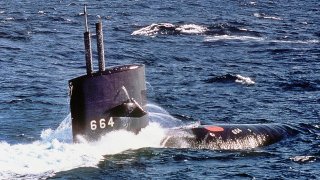Sturgeon-Class Submarines: The Backbone of U.S. Cold War Naval Power
During the Cold War, U.S. and Soviet submarines engaged in tense undersea duels. The U.S. Navy's Sturgeon-class submarines, an evolution from earlier designs, became workhorses in this conflict. Sturgeons were longer, had larger sails for improved intelligence gathering, and featured rotating fairwater planes for Arctic operations.
Summary and Key Points: During the Cold War, U.S. and Soviet submarines engaged in tense undersea duels. The U.S. Navy's Sturgeon-class submarines, an evolution from earlier designs, became workhorses in this conflict. Sturgeons were longer, had larger sails for improved intelligence gathering, and featured rotating fairwater planes for Arctic operations.

-They were also built to SUBSAFE standards, ensuring their safety and reliability.
-The USS Parche, a notable Sturgeon, played a crucial role in Operation Ivy Bells, a daring mission to tap Soviet underwater communications.
Sturgeon-Class submarines, Explained
By the 1960s, the submarine chess matches of the Cold War were in full swing.
U.S. and Soviet boats did their best to tail each other without being detected, attempting to track the other country’s “boomers,” or ballistic missile submarines.
Beginning with the Skate-class vessels, the U.S. Navy had incorporated nuclear power into its sub-fleet.
From those boats, designers developed the Thresher/Permits, which led almost directly to the Sturgeon-class submarine, the workhorse of the Cold War.
Incremental Progress to Sturgeon-Class
The Sturgeons came to life as larger versions of their predecessors, 15-25 feet longer.
Otherwise, they used the same layout as the Thresher/Permit class, which had proven successful. The extra length was used to store more torpedoes in the operations compartment.
In addition to being longer, Sturgeons had a larger sail. One of the major drawbacks of earlier boats, this change allowed for an additional periscope and other necessary intelligence-gathering equipment. It had the added benefit of reducing the sub's risk of broaching in heavy seas - craft with smaller sails had shorter periscopes, requiring them to be closer to the surface to use them where a sudden swell could pop them to visibility on the surface.
The sails contained another innovation: rotating fairwater planes. Since the USS Skate had breached the polar ice at the North Pole on March 17th, 1959, U.S. and Soviet subs had increasingly tangled under the pack ice up north.
Prior to the Sturgeons, the fairwater planes - which project horizontally from the sub and aid in keeping it level during dives and descents - were fixed in place. Their location on the sail meant these boats could not broach thick ice without risking damage to these surfaces, which limited their arctic capabilities. The Sturgeons could rotate their planes 90º to the vertical, allowing them to safely punch through the ice and increasing the arctic effectiveness.

SUBSAFE and the Sturgeon-Class
On April 10th, 1963, the USS Thresher was lost with all hands during routine testing following a maintenance period. Following numerous investigations, the Navy instituted the Submarine Safety Program or SUBSAFE.
While the exact cause of the loss of the Thresher was never determined, the program sought to address concerns surrounding the construction and maintenance of subs. It has proven incredibly successful, as not a single U.S. sub that has been built or retrofitted by the program has been lost.
As the Sturgeons were under construction at the time of the Threshers loss and the rollout of SUBSAFE, they were built to its standards.
These included welding practices for any pipe that contained pressurized seawater, as well as ensuring any opening through the pressure hull larger than a specified size can be quickly shut by a remotely operated hydraulic stop.
Notable Submarine: USS Parche
All the Sturgeons had long and remarkable careers throughout the Cold War, serving in the fast attack role to tail Soviet subs and gather intelligence. Foremost among them was the USS Parche, SSN-683.
The fourth-from-last Sturgeon built when she launched in 1970, the Parche was one of the longer-hulled variants. Throughout her career she undertook a variety of missions, however, she is most well known for her intelligence work against the Soviet Union in Operation Ivy Bells.
Begun in the early 1970s, Operation Ivy Bells was a wiretap of a submarine Soviet telephone line between the sub base on the Kamchatka peninsula and the Pacific Fleet base in Vladivostok. Although the Sea of Okhotsk was heavily patrolled and monitored by an underwater sonar network, the Navy, CIA, and NSA judged it was worth the risk to try to tap into Soviet communications.
Initial operations to install the wiretap were undertaken by the USS Halibut, however, the Parche soon took over duties recovering the tapes and installing new ones. She earned a multitude of Presidential Unit Citations among other awards and was, as of 2007, the most highly decorated vessel in U.S. Naval history.

Later, the Parche was modified with an additional 100’ hull section added just forward of her sail. Completed in 1991, the overhaul allowed her to carry out even more sophisticated intelligence gathering, a role she excelled at until her decommissioning in 2005, 5-10 years after many of her sister ships.
About the Author
Maya Carlin, a Senior Editor for National Interest, is an analyst with the Center for Security Policy and a former Anna Sobol Levy Fellow at IDC Herzliya in Israel. She has by-lines in many publications, including The National Interest, Jerusalem Post, and Times of Israel. You can follow her on Twitter: @MayaCarlin.
All images are Creative Commons.


